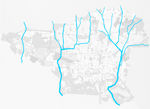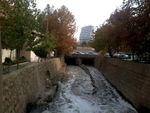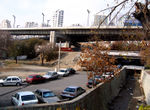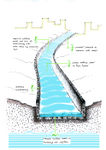Green Infrastructure 2014 Group L - Case Study 2: Difference between revisions
Shahmoradis (talk | contribs) |
Shahmoradis (talk | contribs) |
||
| Line 70: | Line 70: | ||
Image:Connection of Open Spaces by the River.jpg|Connection of Open Spaces by Darband River Valley | Image:Connection of Open Spaces by the River.jpg|Connection of Open Spaces by Darband River Valley | ||
Image:Main Roads Crossing The River.jpg|Main Roads Crossing The River | Image:Main Roads Crossing The River.jpg|Main Roads Crossing The River | ||
Image: | Image:Effects of Covering the Bed of the River on Environment.jpg|Effects of Covering the Bed of the River on Environment | ||
Image:your drawing.jpg|your drawing | Image:your drawing.jpg|your drawing | ||
</gallery> | </gallery> | ||
Revision as of 15:24, 21 November 2014
---> back to group page working group L
please add your title here
| Name | Darband River Valley | |
| Country | Iran | |
| City | Tehran | |
| Authors | Shahla Shahmoradi | |

| ||
|
| ||
Rationale: Why is this case interesting?
River valleys are a valuable feature of Tehran in this arid climate. They act as lungs of a city which bring fresh air from mountains. Unfortunately, there is not much attention to this natural feature in Tehran. Actually, in many parts of the city, their beds have been covered by non-permeable materials, and even worse they have been replaced by highways with a lot of natural and social consequences. On the other hand, Tehran is also a metropolitan with huge inner-city travels and a burgeoning interest in walking and biking. However, there are not safe and enjoyable spaces to comfortably walk and bike. I see these river valleys a great opportunity to convert to an ecological pathway. Besides discharging stormwater, they have a remarkable potential to more integrate communities, more tie people to nature, make people healthy, and provide a sustainable delightful transportation network.
Author's perspective
On one of the projects at my previous workplace, I, as a team member, worked on adjacent neighborhoods of a highway. This highway passed through tight neighborhoods with strong relationships. After detailed studies, we found out this highway caused extraordinary disintegration within the communities so that even some children had to cross over the highway to reach their schools. After living near one of these highways which once was a river valley, I have more deeply perceived this disintegration as well as huge noise and air pollution. This has always been my challenge that following this fact that we have a lot of north-south river valleys which have a great potential to convert to a green infrastructure and we need more ways, why we don’t restore these valleys and improve green transportation with the help of them. More dedicating spaces to automobiles means more pollution, more congestion, more illnesses, and more disintegrated communities, while providing delightful environments to walking, biking, and convenient public transportation means more healthy citizens, more environmentally friendly infrastructures, and more sustainable environments and communities, which is what river valleys can give us. Sometimes, I really desire to bike or walk to my destination but in this polluted and automobile-oriented city, I hardly even persuade myself to go out! I believe this metropolitan with burgeoning population and inner-city travels needs a redefinition of their transportation network toward a sustainable future. My intention of studying this case is restoration of river valleys with the approach to green, high quality pathways.
Landscape and/or urban context of your case
- Main River Valleys in the City
Seven main river valleys pass through the city, including Darakeh, Velenjak, Darband, Golab Dareh, Jamshidyeh, Darabad, and Kan. All of these come from North Mountains of Tehran, and after passing through urban areas reach lower plains in the south, where they meet agricultural lands. My case study concentrates on Darband river valley, which passes alongside my neighborhood.
- Overall Character
By carefully looking at the map, Darband river valley and its path is recognized due to its especial natural form. But if we want to follow it in the city, it is not so easy. Some parts of it have been buried under buildings or streets. Other parts of it have been converted to "U" channels and covered by non-permeable materials such as stone. In terms of flora, except some scattered trees , which are planted alongside the wall of the river valley, there is not major planting adjacent to that. Actually the deep channels surrounding the bed of the river valley has taken the opportunity to plant trees, shrubs, or other kinds of vegetation. Right after the end of the river's walls, there are streets and buildings. This lack of attention to Darband river valley causes people to undermine it and throw their wastes in this river-channel, and this in turn causes major environmental pollution in the site.
- Flora
Tehran is rich in terms of the diversity of flora. While some of them are native to Iran, few, if any, of them are endemic to Tehran. Up to now, 13 endemic species of Tehran are known: Eritrichium mertonii (Family Boraginaceae), Buffonia hebecalyx (Family Caryophyllaceae), Stellaria scaturiginella (Family Caryophyllaceae), Centaurea carduiformis subsp. iranica (Family Compositae), Tanacetum polycephalum subsp. junesarens (Family Compositae), Taraxacum darbandense (Family Compositae), Convolvulus gracilininus (Family Ipomoea), Astragalus latianicus (Family Papaveraceae), Astragalus pseudobrunsianus (Family Papaveraceae), Hedysarum elbursense (Family Papaveraceae), Hedysarum hyrcanum var. hyrcanum (Family Papaveraceae), Vicia sojakii (Family Papaveraceae), Galium tehranicum (Family Rubiaceae). All of these species are herbaceous, which aren’t currently used in parks and landscapes. Predominant species of Tehran which are widely planted in parks, streets, and open spaces as well as alongside the river valleys are Platanus orientals, Morus nigra, Ulmus minor ‘umbraculifera’, Fraxinus excelsior, Quercus spp of broadleaved trees; Pinus eldarica and Cupressus arizonica of conifers; Lignustrum vulgare, Viburnum opulus, Nerium oleander, Berberis thunbergii of shrubs; and Common grass and Hedera helix of cover plants.
- Connectivity to the Wider Green/Blue Structures
Darband river valley in its journey from North Mountains toward plains through the middle of the city links many important services and facilities from urban to local scales. One of the most important facilities is North Mountains itself, which during the week and weekends attract thousands of people to hike, mount, and spend leisure time. On the other hand, the river valley passes through main, high traffic roads and highways, which everyday millions of citizens use to go their work. All of these green/blue structures stress the importance of this historical river valley and affect the river both negatively and positively. Before such an incredible development of the city, when all of the city with its borders was limited to current city center, most parts of these river valleys were far away from the city and its effects. At that time, mostly private gardens formed their banks.
- Illustrations: maps; sketches; short descriptive analyses
- Illustrations
Analytical drawings
- Please use analytical drawing for visualising the conflicts/potentials of your site
- Analytical Drawings
- Your drawing.jpg
your drawing
Green Infrastructure benefits for this site
Look again at the multiple benefits of green infrastructure - what could be achieved in your site and which are most relevant?
Potential for multifunctionality
Green infrastructure has typically multiple functions. What could be achieved for your site in this respect?
Projective drawings
- How would you like this case to change in the near future? (in 1-2 years)
- you may add a short explanation here
- And how could it look like in 10-15 years?
- you may add a short explanation here
- Projective Drawings
- Yourdrawing.jpg
projective drawing
- Yourdrawing.jpg
projective drawing
- Yourdrawing.jpg
projective drawing
- Yourdrawing.jpg
projective drawing
Summary and conclusion
- 100 words approx.
Image Gallery
Please add further images/photos here
- Image Gallery
- Yourimage.jpg
your image text
- Yourimage.jpg
your image text
- Yourimage.jpg
your image text
- Yourimage.jpg
your image text
- Yourimage.jpg
your image text
- Yourimage.jpg
your image text
- Yourimage.jpg
your image text
- Yourimage.jpg
your image text
References
- please add your references here
About categories: You can add more categories with this tag: "", add your categories








